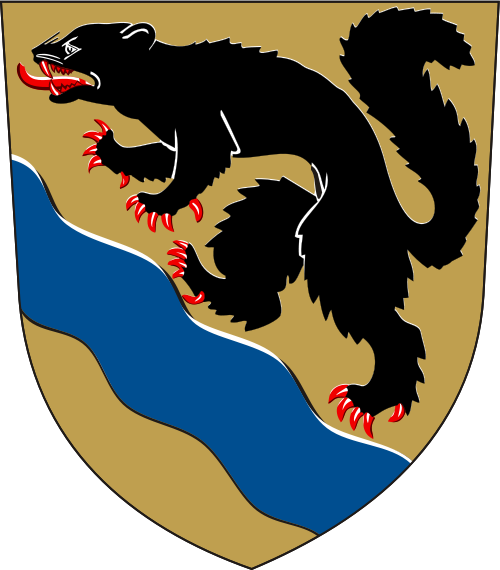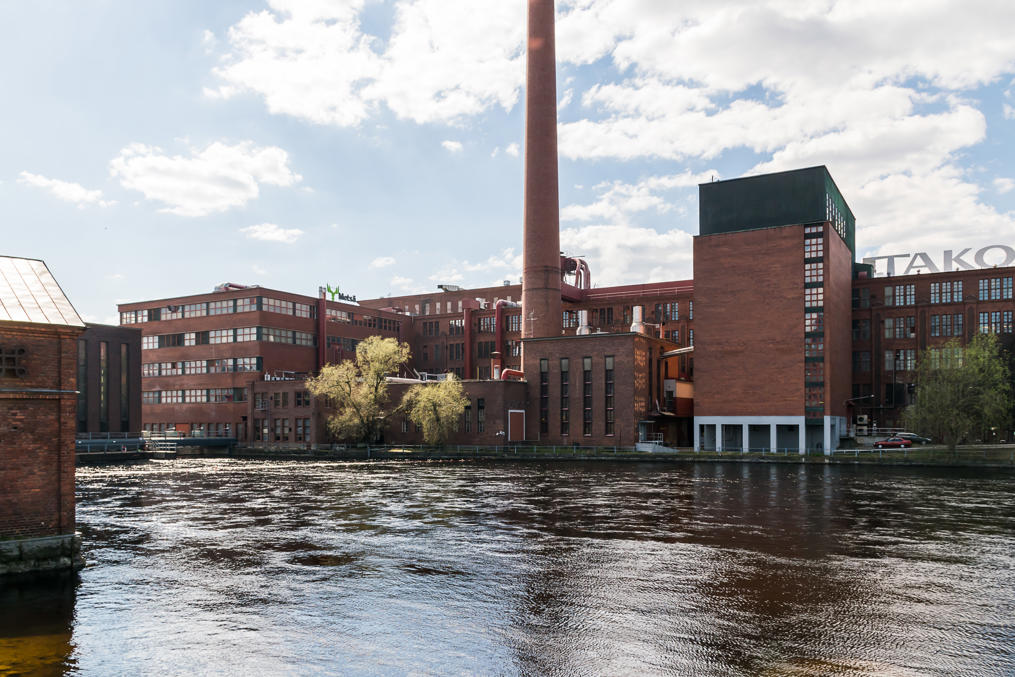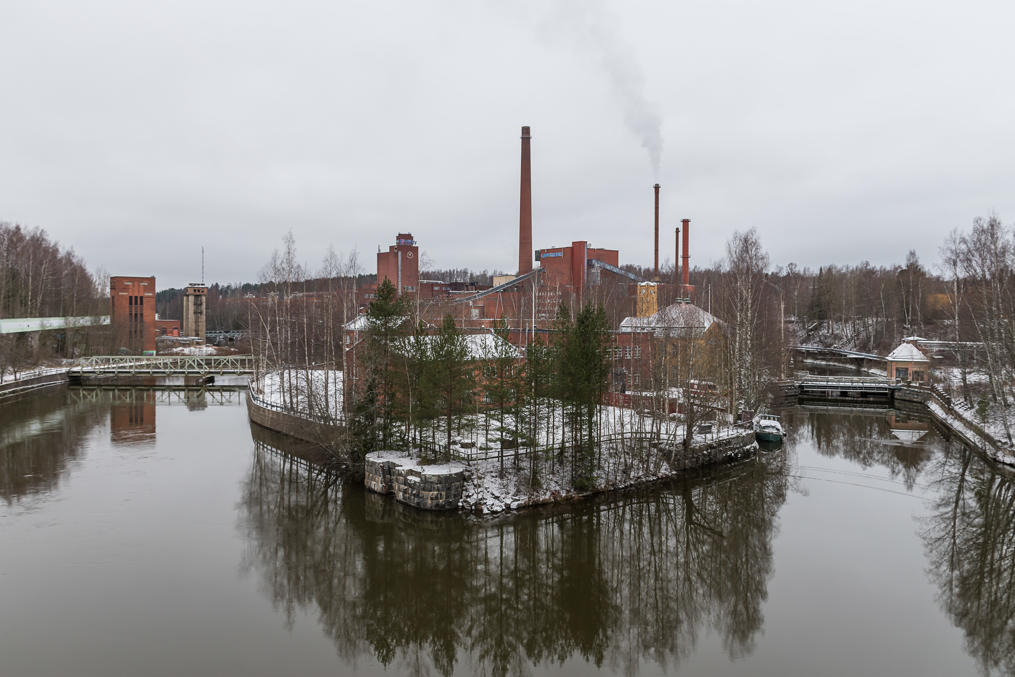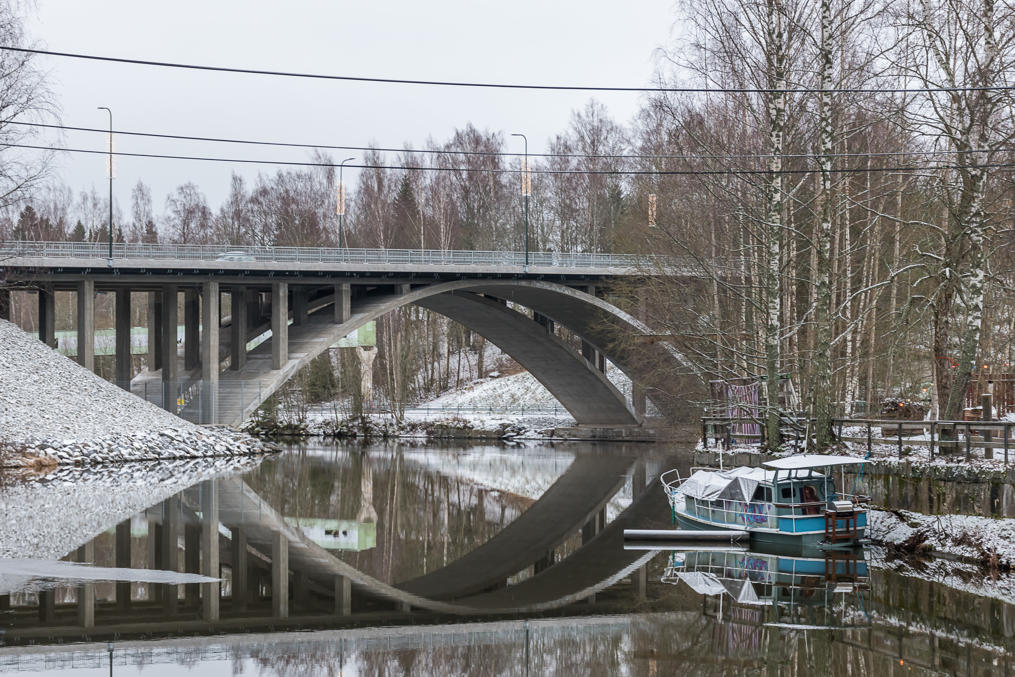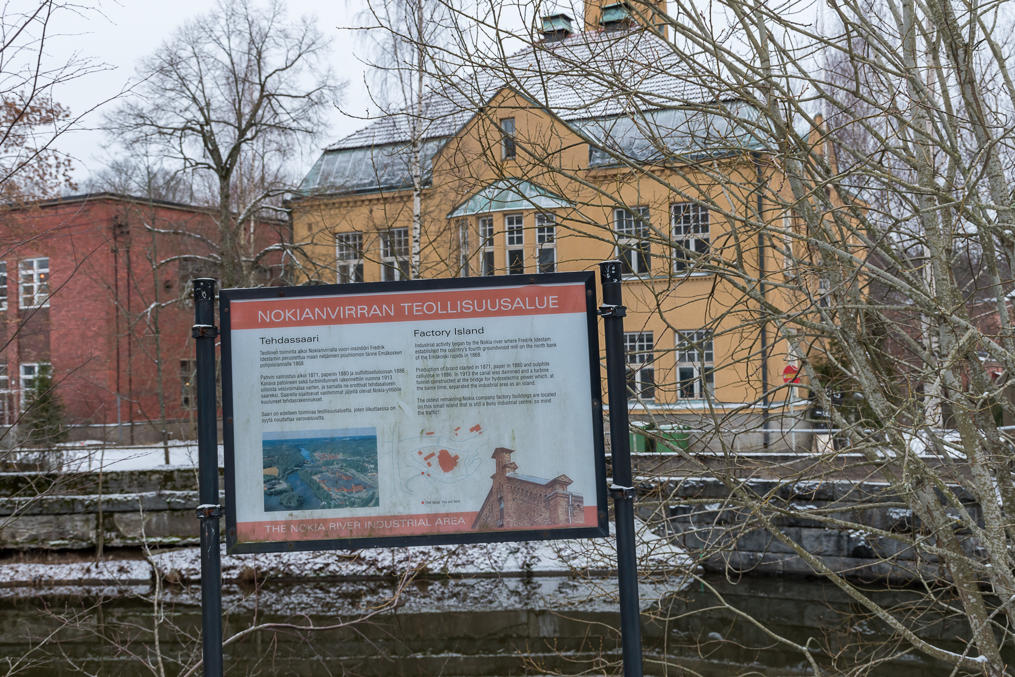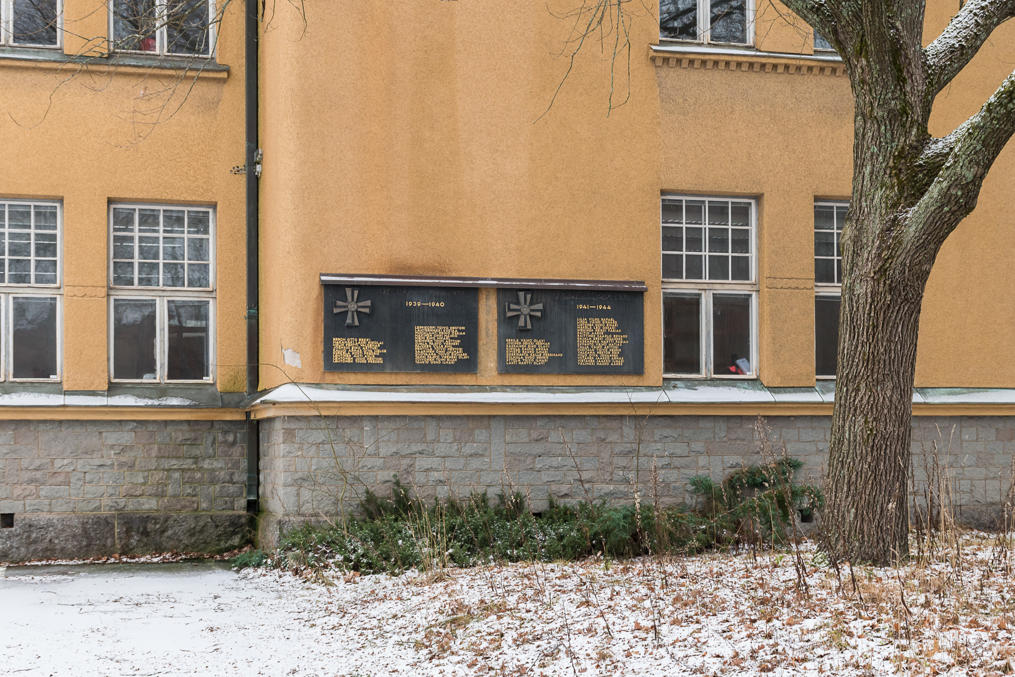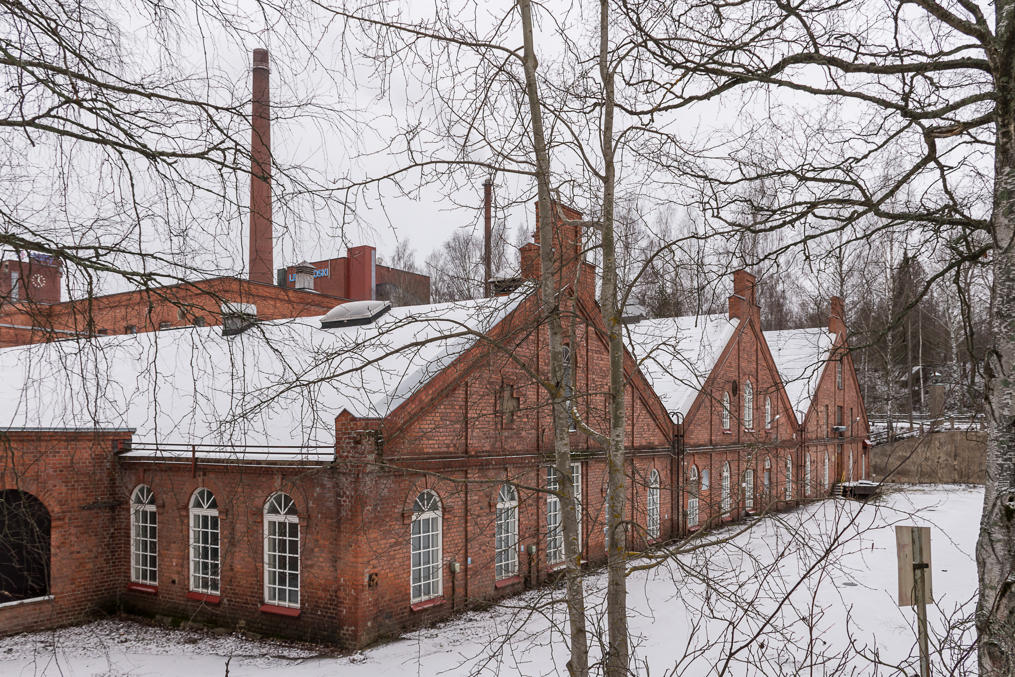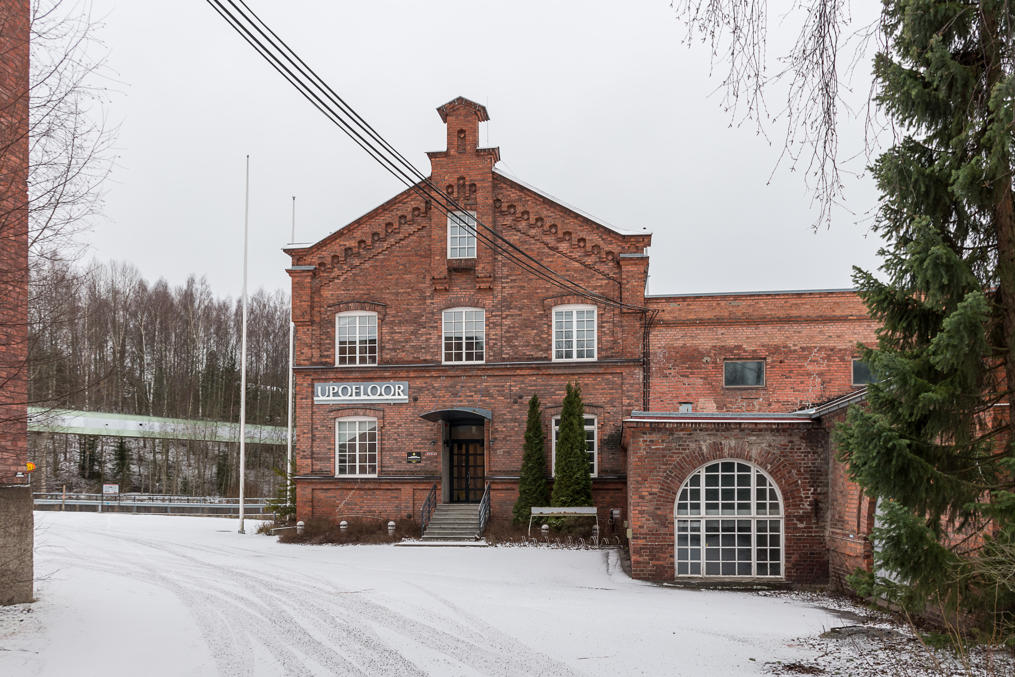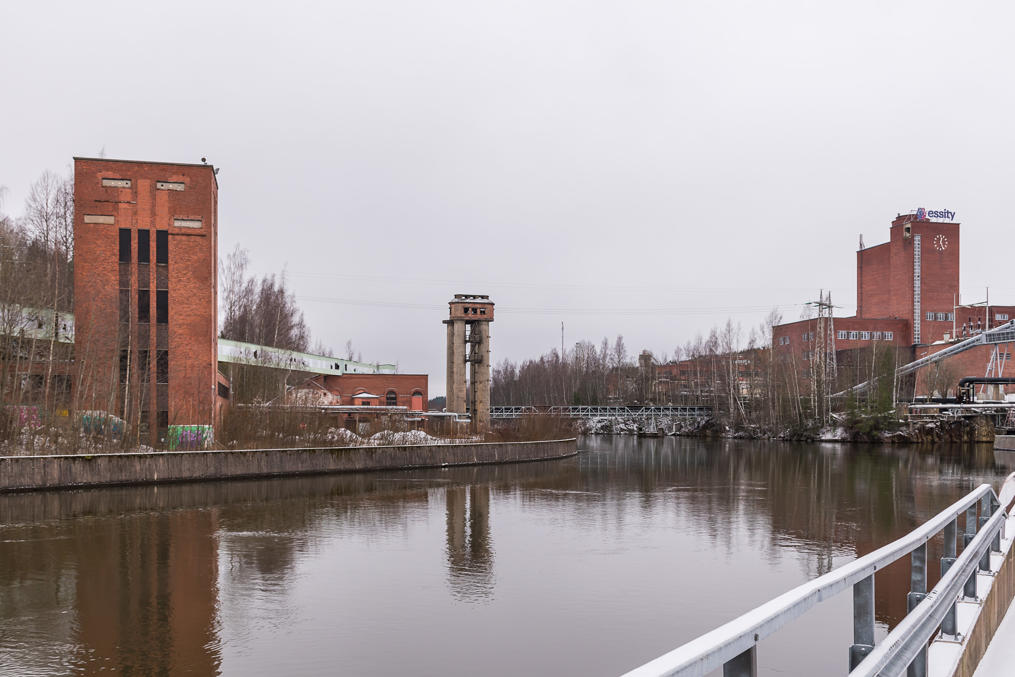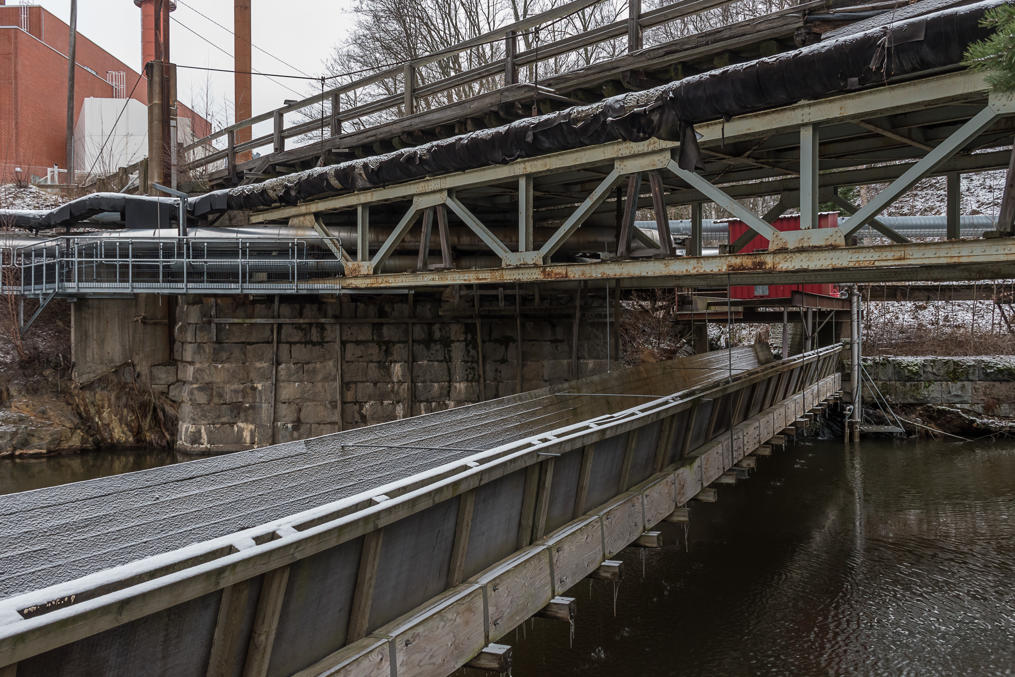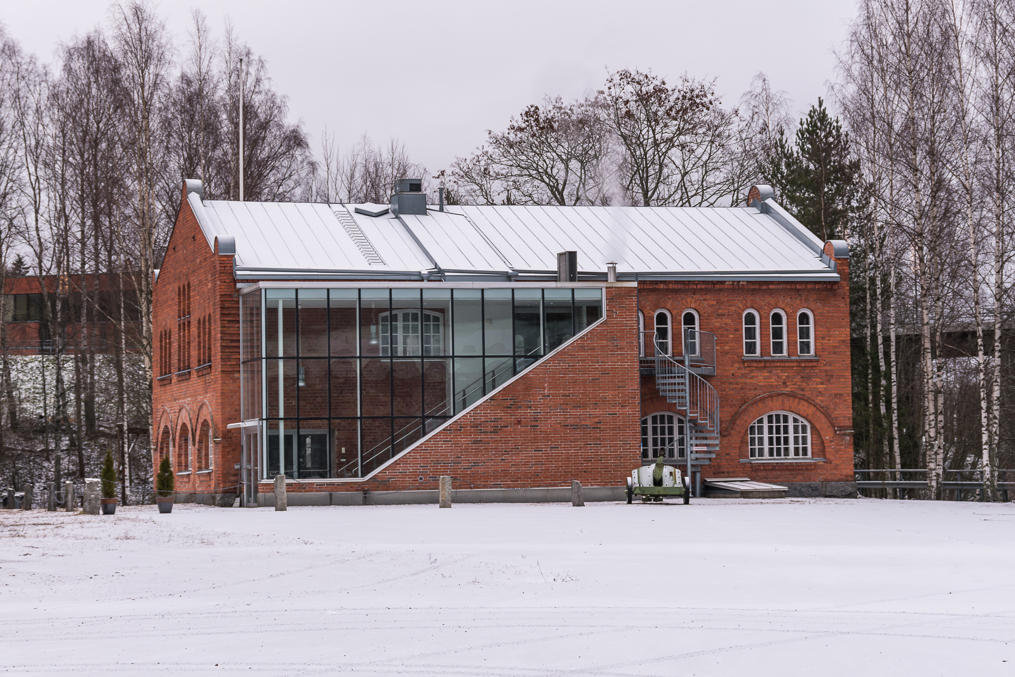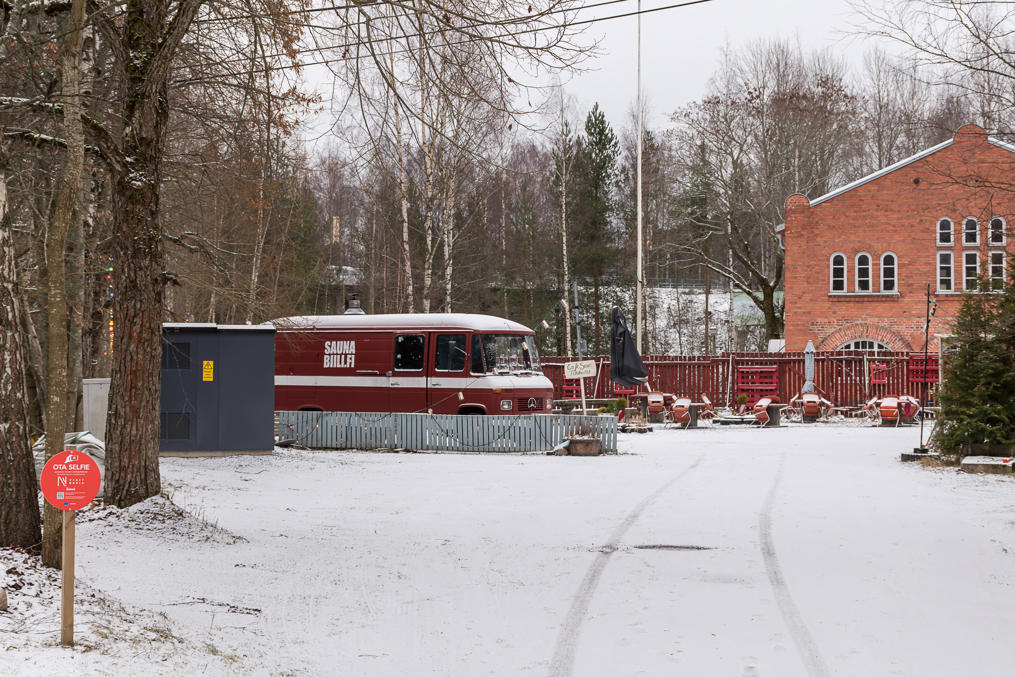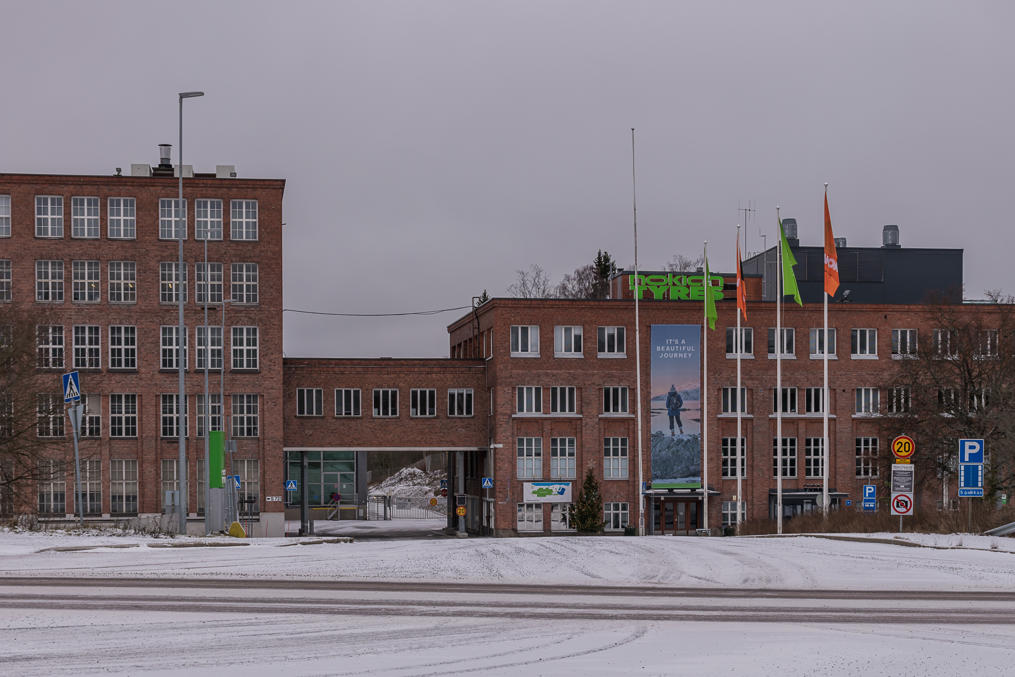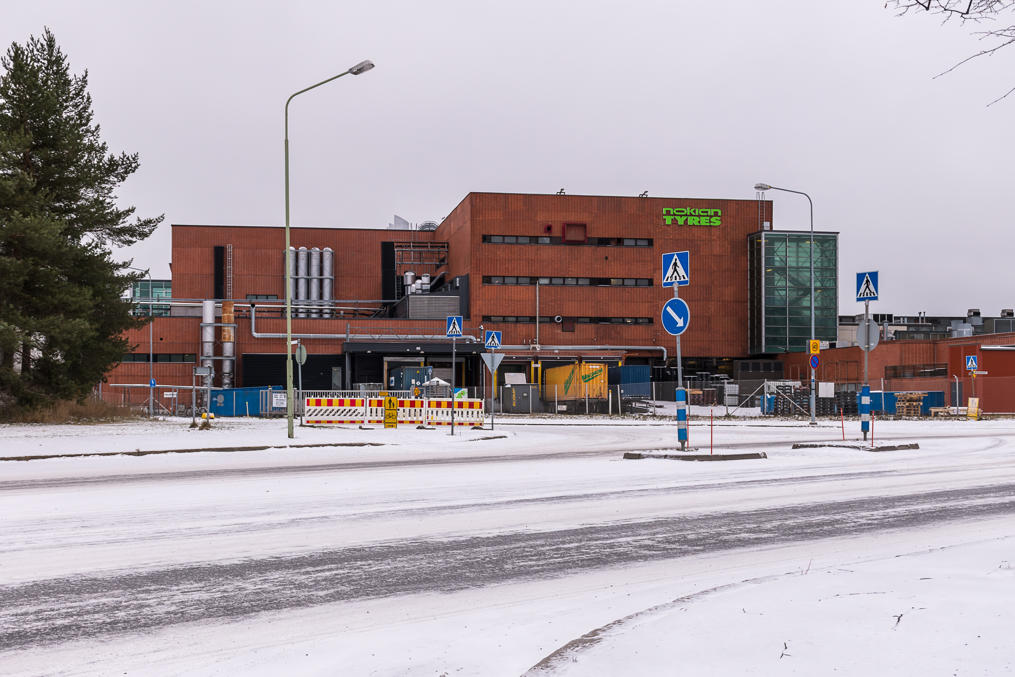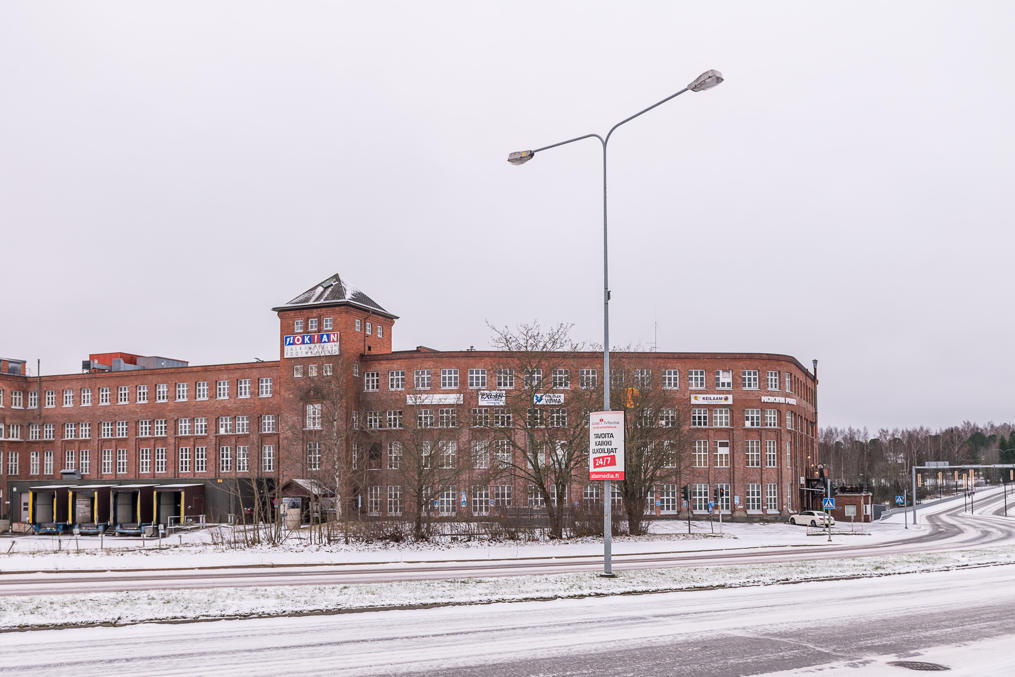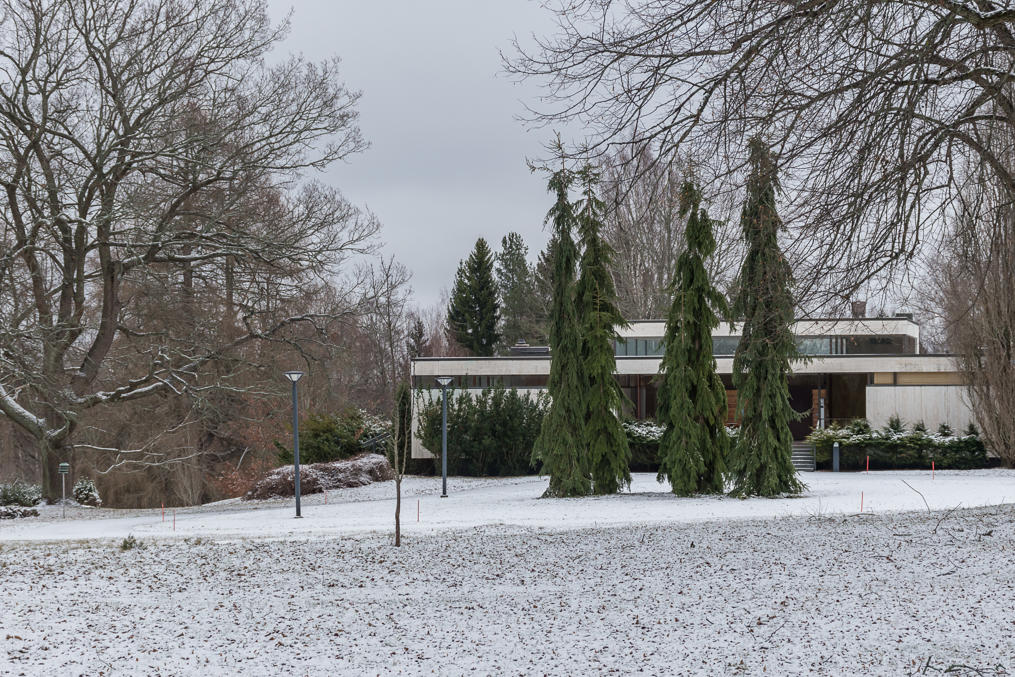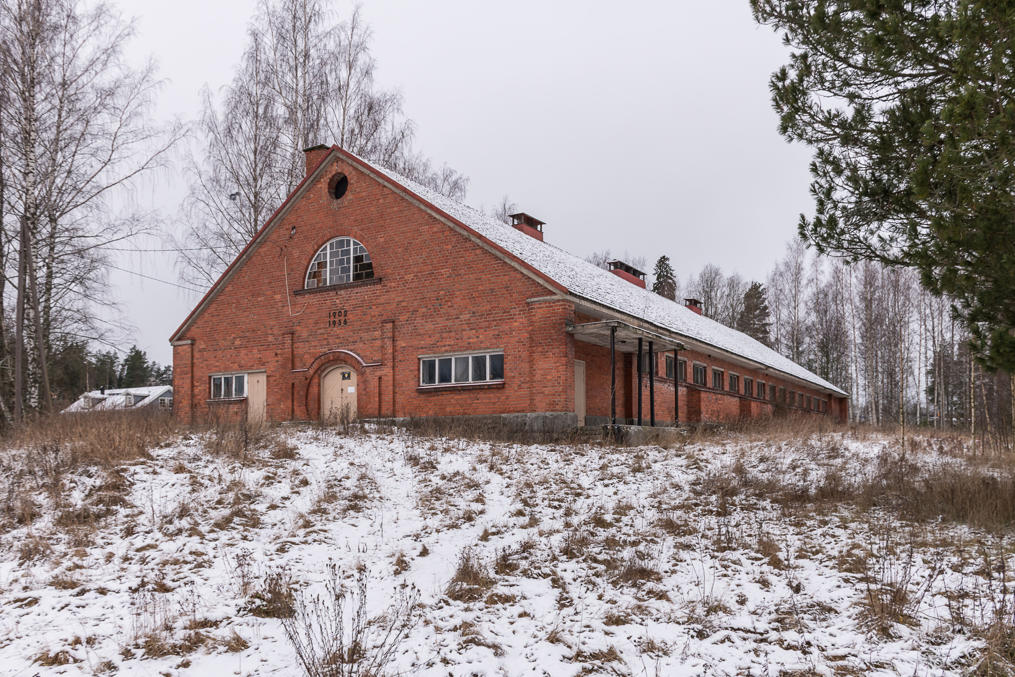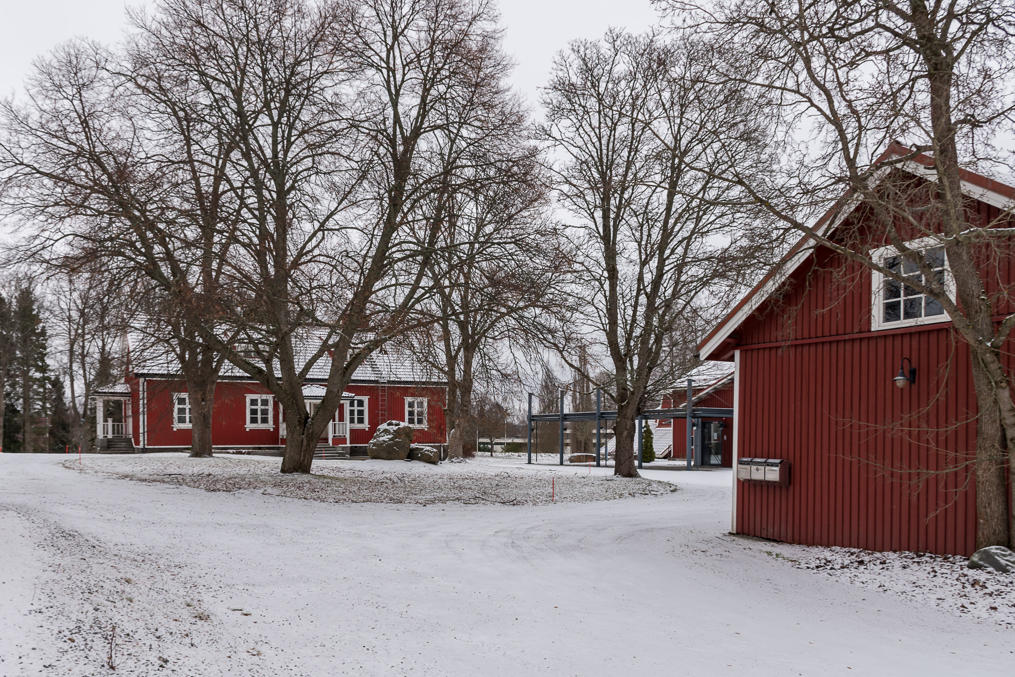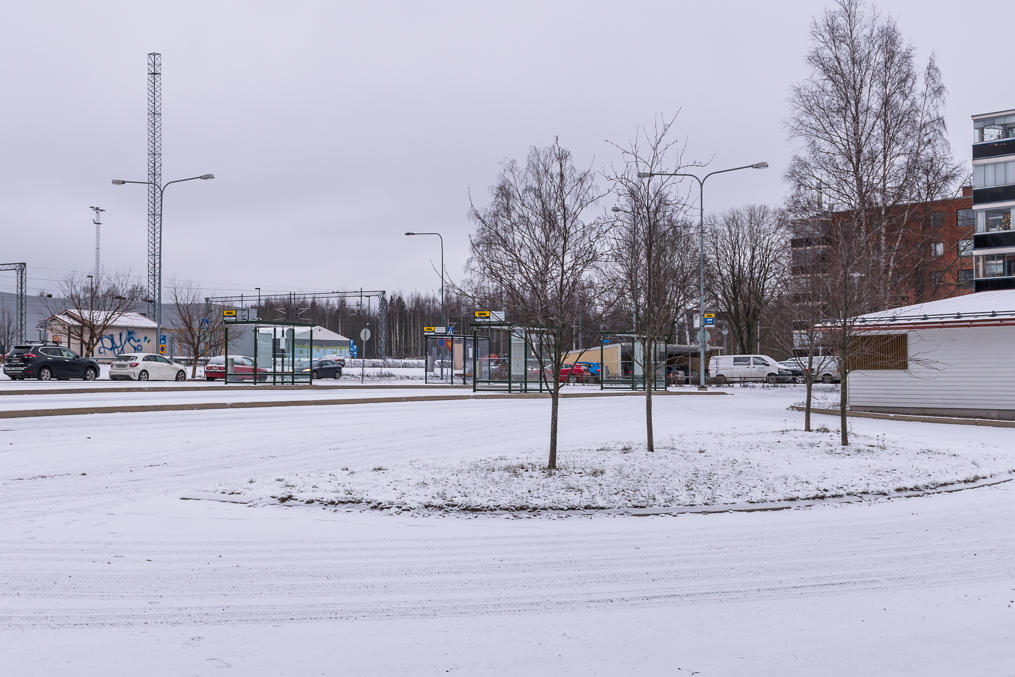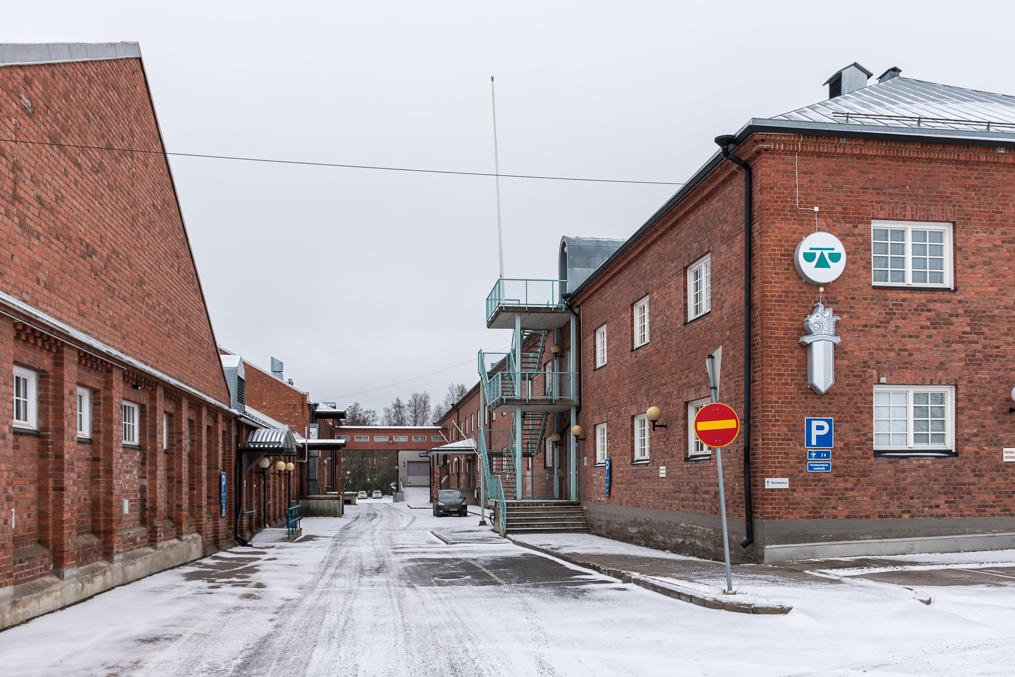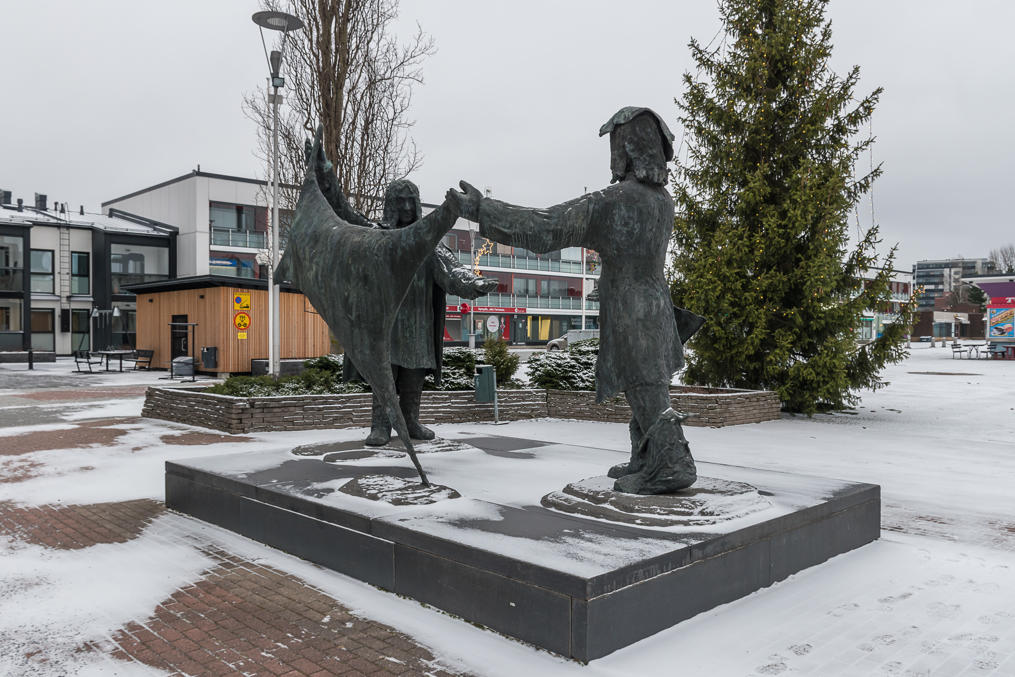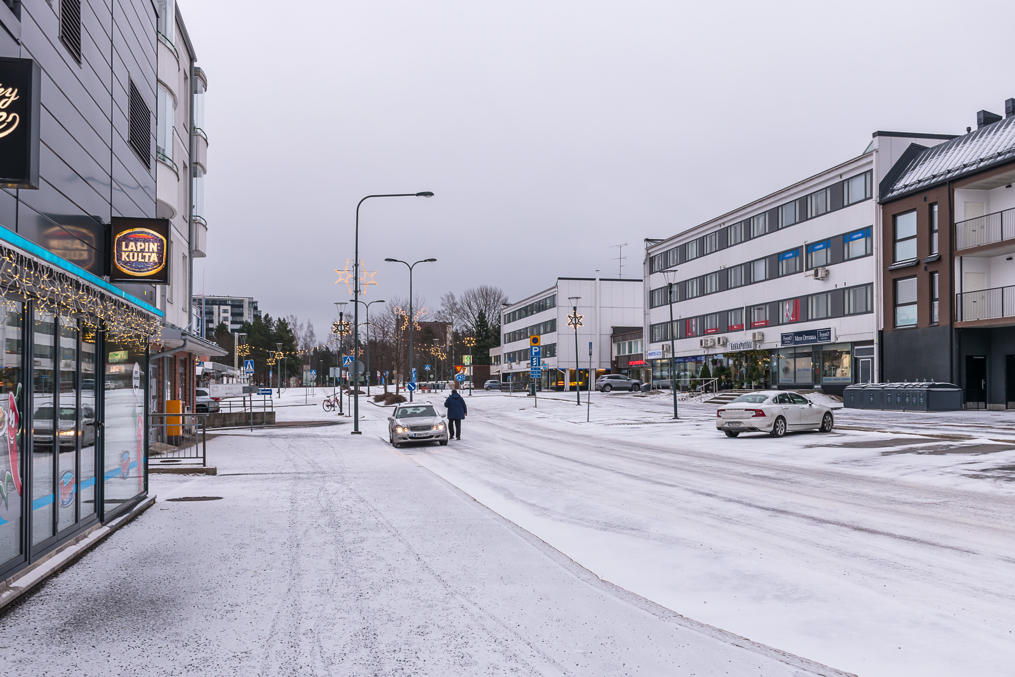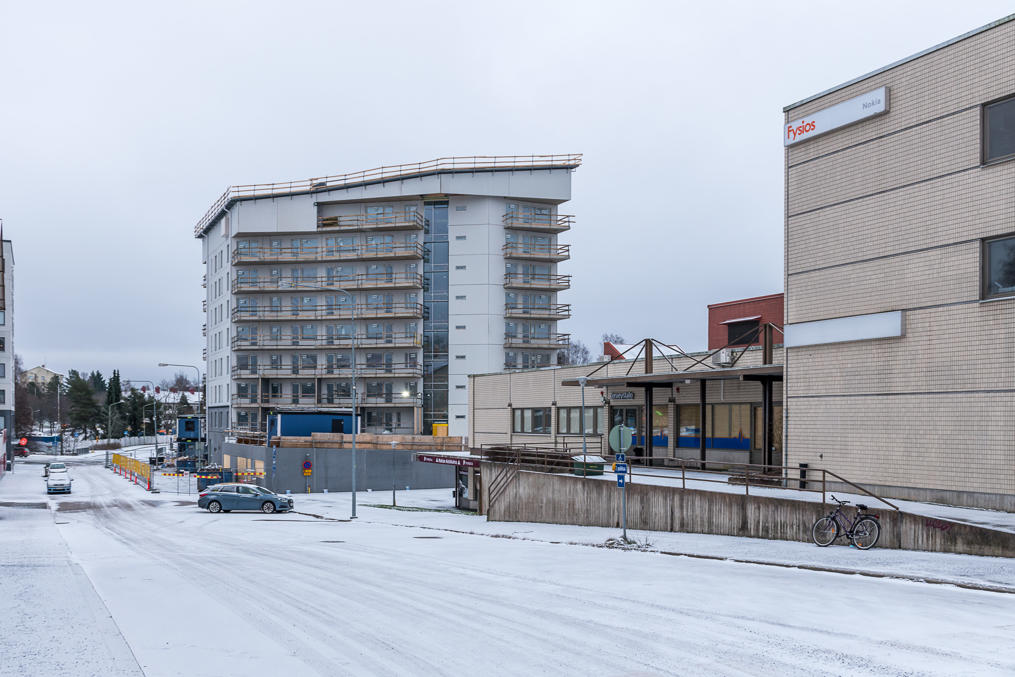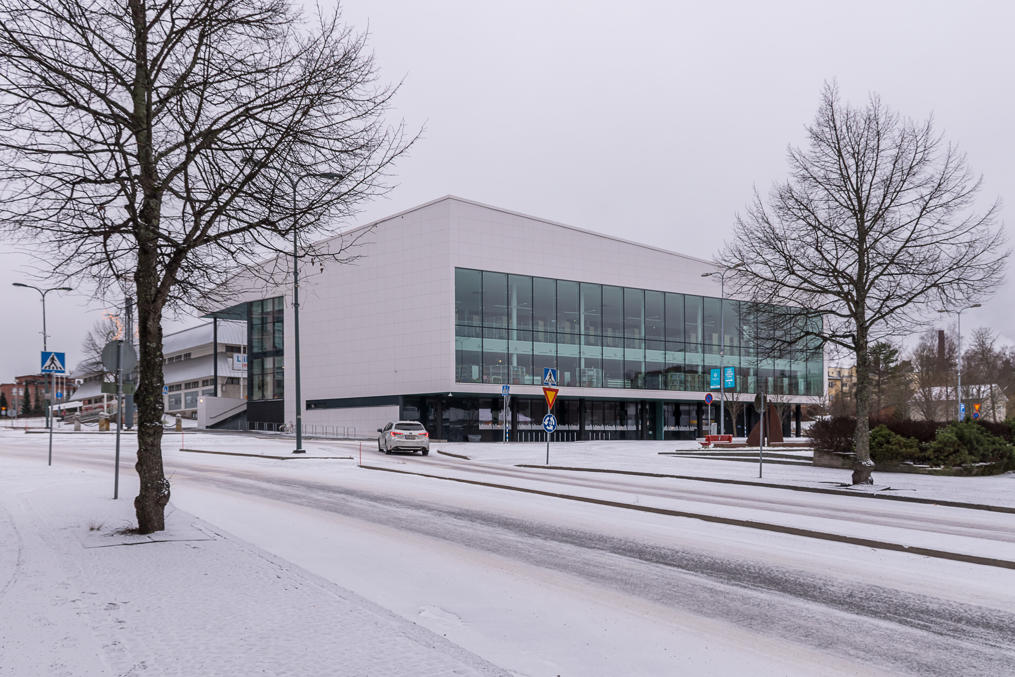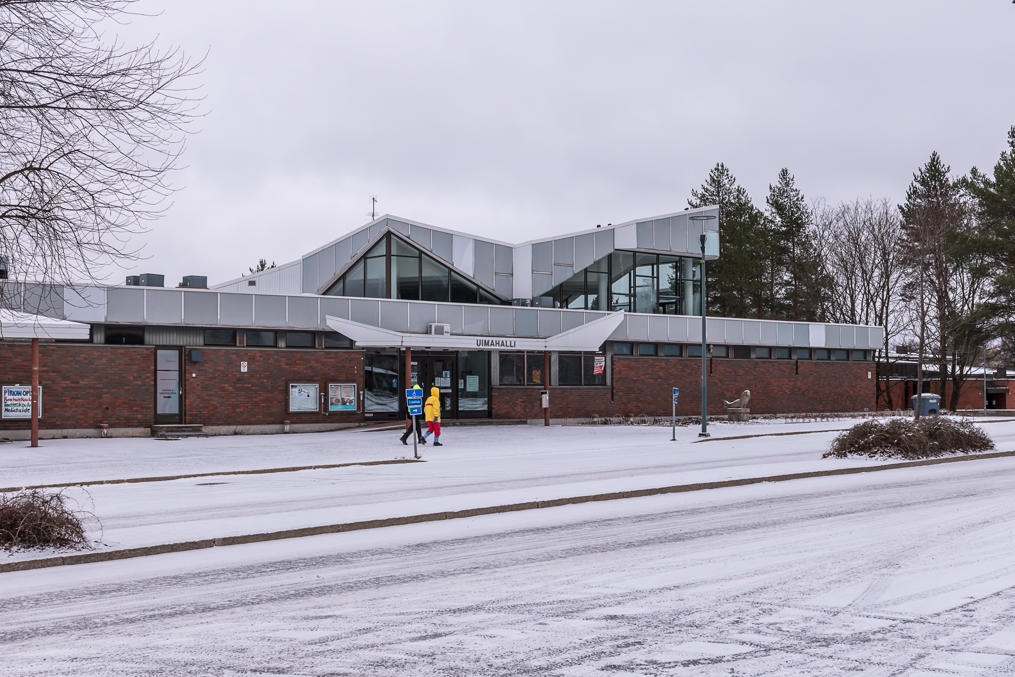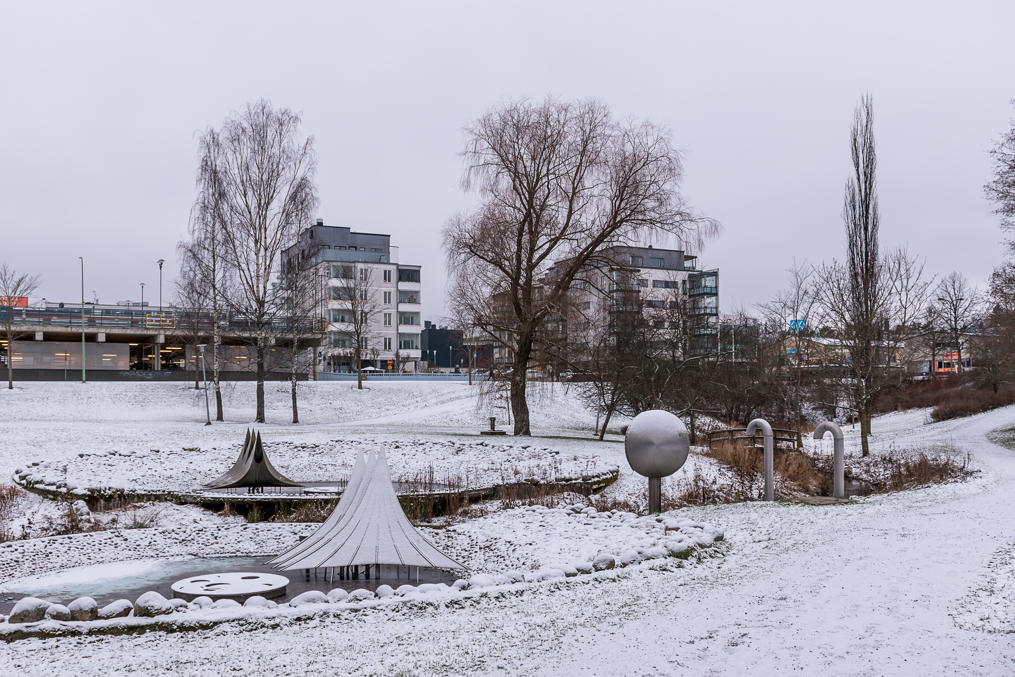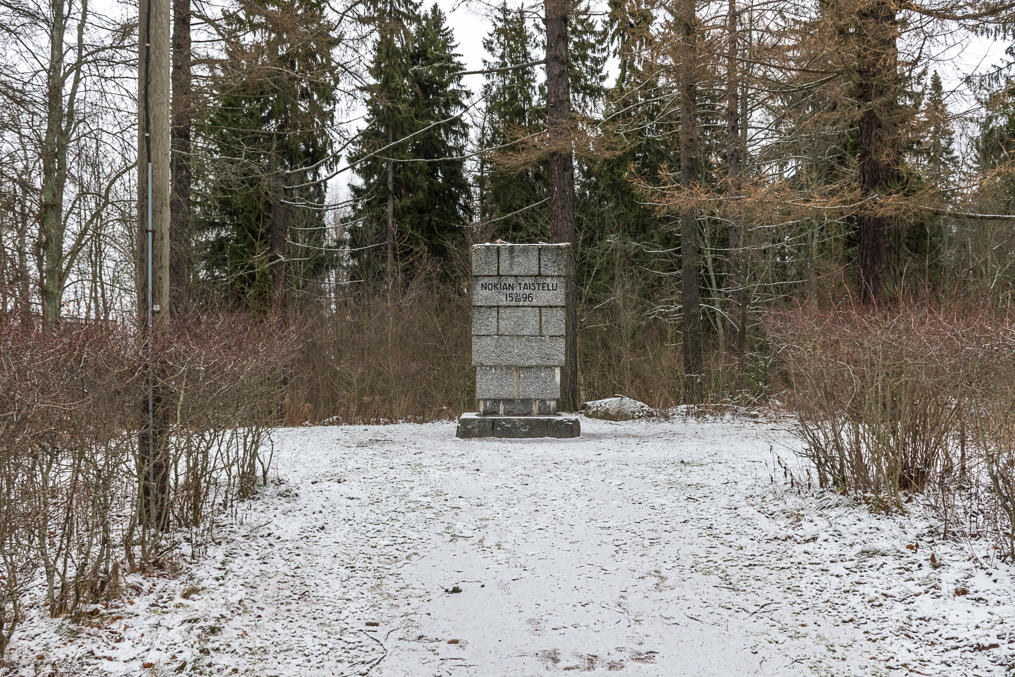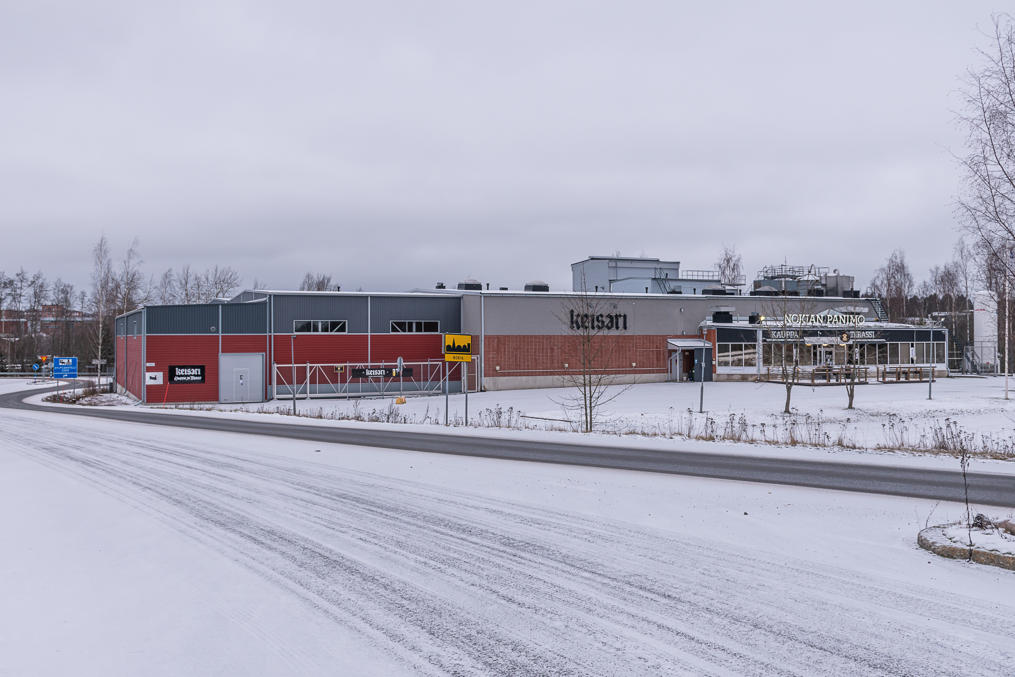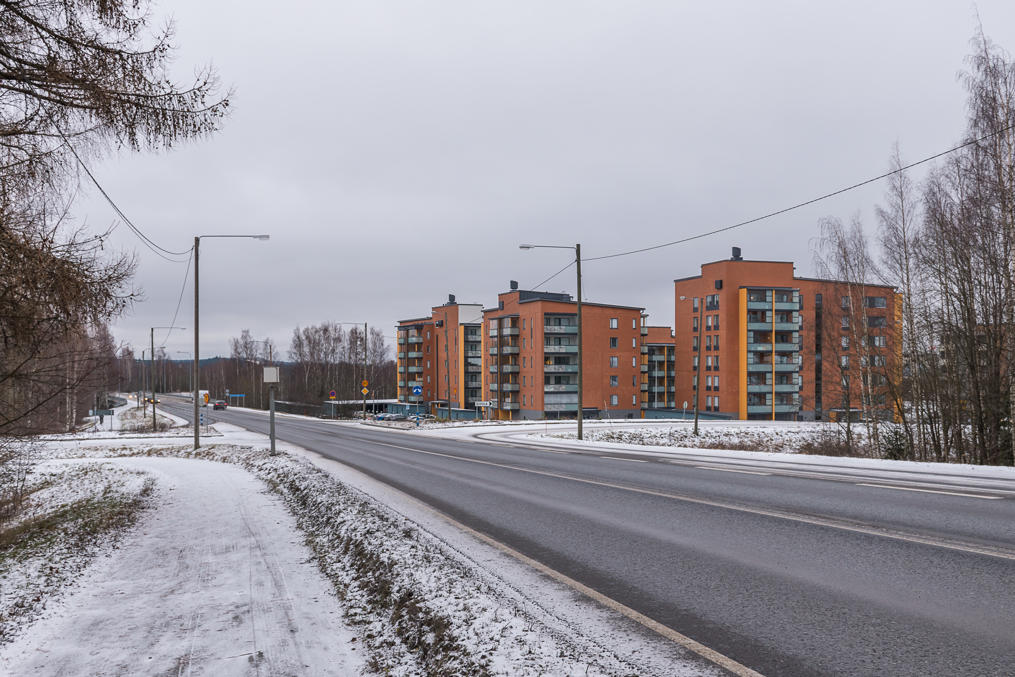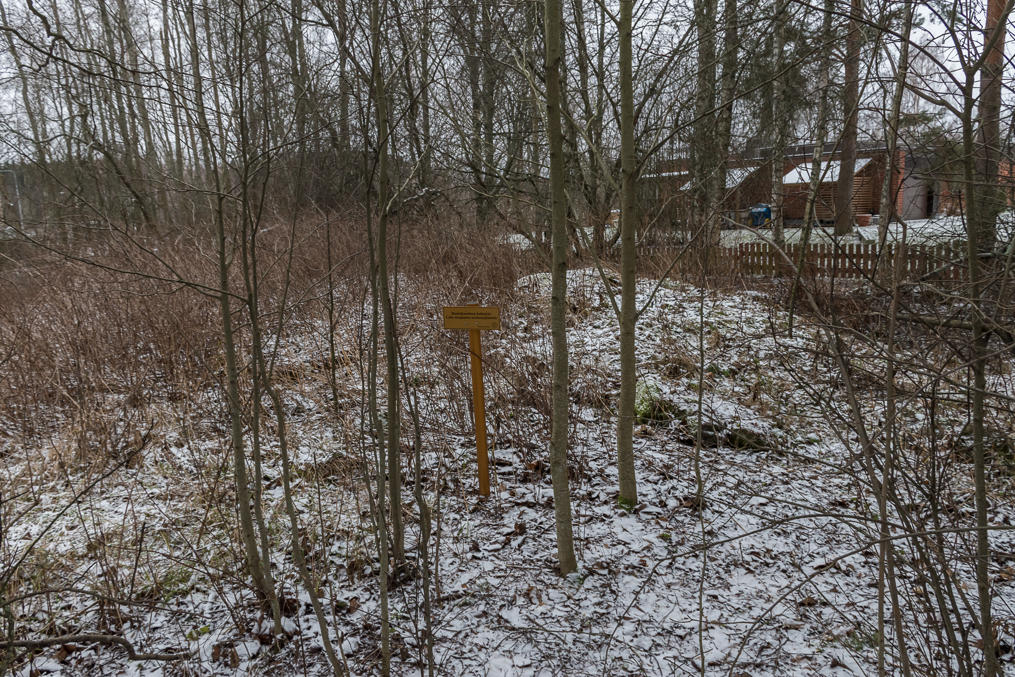In the city of Nokia the oldest surviving buildings that ever belonged to the, well, Nokia company are currently being auctioned off.
Many probably know that Nokia company is named after the city of Nokia, which nowadays is the western and the biggest (population 34,300) suburb of the large city of Tampere. This place, by the shores of a wild but fairly short Nokianvirta river, the Nokia Stream, was a center of trade in prehistory, and the word Nokia supposedly comes from the archaic Finnish word nois, meaning a sable or possibly a beaver, since their hides were a major trade item. (It was traditionally assumed to be a sable, but those never actually lived anywhere within Finland; in any case the modern coat of arms of the city features a pine marten.) The powerful rapids of Nokianvirta were however for a long time only used for some minor water mills.
The father of the Nokia industry was Fredrik Idestam (1838-1916). His father Gustaf Idestam (1802-1851) was a local bergmeister and one of the founders of the Tampella blast furnace in Tampere. The city of Tampere, founded in 1779 at another powerful rapids, Tammerkoski, is known as the cradle of the Finnish industry, but it took many decades from the establishing of the city for this industry to actually take shape. Fredrik followed his father's steps, but he was more interested in paper production, the industrial process for which he got familiar with in Germany.
In 1865 Idestam established a pulp mill in Tampere at the lower part of the great Tammerkoski rapids. It was the first of its kind in Finland — of any importance, anyway; a small pulp mill was also built in 1860 in Hounijoki, these days Buslovka (Бусловка), near Vyborg, but struggled a lot and did not last for very long. A pulp mill is an industrial facility producing wood pulp from timber, and wood pulp is one of the possible intermediate materials for paper production. While paper was invented many centuries ago, and the first paper mill was built in Finland in 1842 (also in Tampere, the Frenckell factory, immediately next to the city central square), that paper mill like many others around the world produced paper from rags (cotton cloth), which was fairly expensive. Truly cheap and mass scale paper production from timber was invented in the 1840s. This necessitated mechanical grinding wood into pulp at pulp mills.
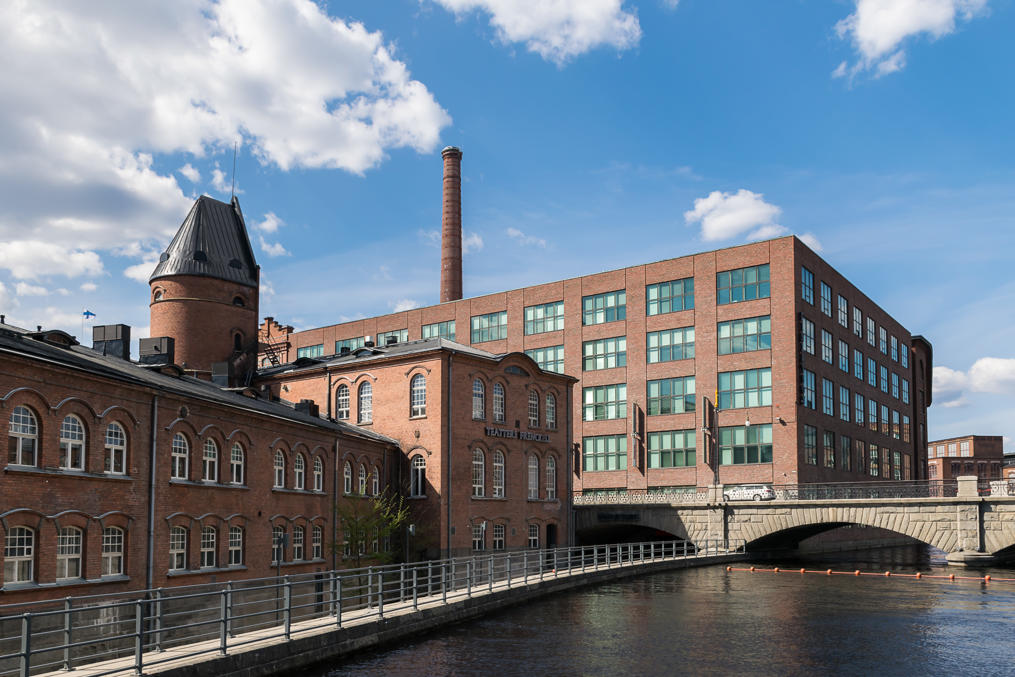
In 1868, in a few years after the first pulp mill was built in Tampere, Idestam built another one in Nokia, at the rapids of Nokianvirta. In 1871 he established a company that would operate the mills, and that company's name, of course, was Nokia. Regardless of that date, it is traditionally considered that Nokia started in 1865 with the first pulp mill.
The original Tampere pulp mill was sold off in the same year, 1871. It actually still exists today, known as Tako cardboard mill, and belongs to Metsä Board corporation. (It thus produces cardboard now, and does not actually manufacture its own pulp anymore.) In the landscape of Tammerkoski in Tampere center, lined with various old industrial buildings of red brick, Tako mill is the only industrial facility that is still actually operating to these days; other factory areas (most importantly Frenckell paper mill, Finlayson and Tampella) have been converted for office or other use. Plenty of industry of course still exists in Tampere, just not in the center.
Nokia pulp mill however remained in the hands of the Nokia company. Paper production started in Nokia in 1880, and a chemical pulp mill in 1885. While in mechanical pulp mills timber gets broken into pulp, well, mechanically (although possibly with heat or chemicals involved), in chemical mills timber is partially dissolved chemically, so that only cellulose fibers remain. Both basic processes are still in use today, although both were developed over time; mechanical pulp is cheaper and is used mostly for newsprint and the like, while chemical pulp produces better quality paper, which is also harder to tear (as cellulose fibers do not get damaged during manufacture).
The paper mills were the oldest, but not the most important part of the Nokia company. In 1898 Eduard Polón (1861-1930), a Finnish businessman and political activist, established the Suomen Gummitehdas (Finnish Rubber Factory, gummi from gum arabic) in Helsinki, and moved it to Nokia in 1904, where it operated just a short distance from the paper mills. In 1918 Polón bought the Nokia company (which had been close to bankrupcy at the time), and in 1922 also Suomen Kaapelitehdas (Finnish Cable Factory) in Helsinki, established only a few years before. The Nokia concern was thus born of a fusion of three industries: paper, rubber and electrical equipment; but still for a long time the three companies remained separate, with Suomen Gummitehdas owning the other two (as Finnish laws didn't allow the complete fusion at the time). Nokia as a brand name also comes not from Nokia the paper mill but from Suomen Gummitehdas, as it had been making Nokia-branded rubber boots ever since it moved to Nokia. Of course over time Suomen Gummitehdas acquired some more companies and diversifed some more, too. The three companies were finally merged into one big Nokia in 1966.
Nokia as a megacompany didn't last all that long, though. Its telecommunications business, for which of course it is known almost exclusively now, started in 1960 as the electronics division of Suomen Kaapelitehdas. In 1979 Nokia and Salora, a radio and television factory from the city of Salo (SALO-RAdio), established a jointly owned Mobira company for development of mobile phones, and soon Nokia bought Salora outright. Former Salora factories in Salo were where Nokia mobile phones were produced from 1981 to 2012, and Nokia/Mobira stood at the roots of the first cellphone standard, NMT. Concentrating on mobile phones, Nokia shed away all its other divisions. Nokia paper mills were sold off to James River, an American company, in 1989. The rubber division, which by then concentrated on tyres instead of rubber boots, was spun off in 1998 as Nokian Tyres (Nokian Renkaat); Nokia owned its majority until 2003, and currently the biggest (32%) owner of Nokian Tyres is Nordea bank. Cable manufacturing of Suomen Kaapelitehdas, operating since 1961 in Kirkkonummi west of Helsinki, was sold off in 1995, and that plant now operates under the name Prysmian. Other smaller lines of business were likewise sold off in the 1990s.
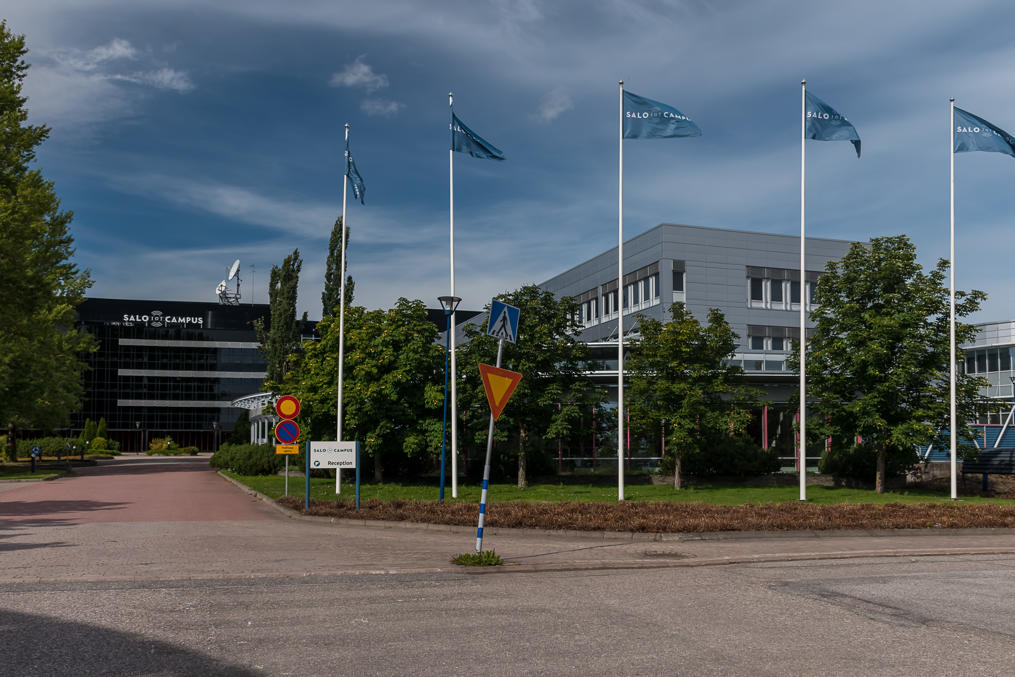
What happened to Nokia afterwards we all mostly know; ultimately as a mobile phone manufacturer it failed, having grown overconfident and stagnant and lost the market to iPhones and Android phones. It stopped building phones in Finland in 2012, which was pretty much a catastrophe for the city of Salo, although its economy has somewhat rebounded since. 3700 jobs were lost in one day, a record for Finland so far. In 2014 Nokia sold off its phone business to Microsoft which shut it down soon afterwards. Nokia's failure sent huge ripples through the relatively small Finnish economy and IT job market. Since 2016 Nokia-branded phones are being sold by HMD Global, a fairly small company in Espoo near Helsinki, to which Nokia licensed the rights to the brand; the actual phones are now Android-based and developed and built in China. Nokia remains as a manufacturer of telecommunication equipment, based also in Espoo and fairly successful in its niche (developing 5G equipment for example) but not very high profile outside Finland anymore.
But in the city of Nokia two of the largest pieces of the original Nokia still operate. Nokian Tyres headquarters and its Finnish factory remain right here where the original Suomen Gummitehdas moved in 1904. As of 2018, 1130 people were employed by Nokian in Nokia, making it by far the biggest private employer in the town. Nokian also owns factories in Russia and the US, and a retail tyre sales and service chain named Vianor.
The paper mill is now owned by Essity company from Sweden and employs "only" 200 people. It went through various changes over the years and currently manufactures tissue paper, as one of the only two tissue paper mills in Finland (the other one is in Mänttä). Lotus-brand toilet paper is for example made here.
The old industrial area in Nokia, close by the city center, nowadays stretches for 1.5 km along the Nokianvirta river, mostly on its northern bank. Its most central and oldest location is Tehdassaari (Finn. Factory Island), an island 250x100 m large, where the former Nokia office and some industrial buildings are located. They are the ones that are now being auctioned off when Upofloor, a floor material manufacturer, moved away from Nokia (concentrating its production elsewhere in the region, in the town of Ikaalinen).
Let's have a look at the old industrial area in Nokia. This won't be a big city tour (as I haven't seen large parts of the city yet) but we still will have a look at the city center too.
1. Tehdassaari as seen from a bridge over Nokianvirta. Tehdassaari, containing the oldest buildings in the area, is an artificial island; on the right (northern) side a short dammed canal separates it from the mainland.
Chimneys in the background belong to the Nokianvirta power plant. The power plant was essentially rebuilt anew in 2016 to replace natural gas use with domestic wood industry products. As far as I understand its major purpose is not electricity production, but rather steam for both Nokian and Essity factories and district heating for the city.
The tower a bit farther to the left with a clock and Essity logo is, well, Essity paper mill. Buildings on the left bank are related to the paper mill but are now all or nearly all abandoned.
2. There are only two bridges in use across the river; the next one is over 20 km downstream, over straits between Kulovesi and Rautavesi lakes. This bridge in Nokia center looks like an older design, but in fact the original bridge from 1957 was demolished due to poor condition and rebuilt completely in 2018-2020. The new bridge is wider than the old one too.
3. It is not especially obvious that Tehdassaari area is open to public (although it is signposted from the road at least), but here it is.
4. Even with information signs! (Which even are not in Finnish only!)
5. The beautiful yellow building by the bridge is in fact the old office of the Nokia paper mill, built in 1908. It is used as a restaurant now.
6. On the back wall of the building are memorial plaques with names of workers who died in wars.
7. And these are the oldest remaining industrial buildings, from 1880-1890s. These are the ones that were occupied by Upofloor company and are being sold now.
8. With the sign not removed, I didn't realize that those are actually vacant.
9. The bridge over the southern (main) fork of Nokianvirta is out of use.
10. Industrial buildings and structures on the southern bank appear abandoned, although that area is still fenced off and there was light on and cameras visible on some buildings. Especially the former pulp conveyor from the lake harbor, with lots of holes in its cover, makes a sad impression. It's not very common in Finland to see such relatively sizable areas in obvious state of decay, although that of course still happens and there's nothing magic about Finland that would prevent it. The abandoned buildings were used for mechanical and chemical pulp production; nowadays the paper mill uses recycled paper and pulp transported from elsewhere in Finland.
11. The paper mill and the power plant.
12. The dam in the northern (canal) fork remains in place, but the building above it is demolished. It's hard to see the details, as the dam is fenced off. The dam was used as the power source for the original pulp mill.
Nokianvirta and in particular Tehdassaari surroundings were changed considerably when Melo hydro power plant 3.5 km downstream was built in 1971. The 9 km long Nokianvirta fell by about 20 meters between its source and mouth; in lower reaches it flowed through a canyon. When the Melo power plant was launched, it made use of this entire 20 m fall, so the water level above it has risen (and covered Emäkoski (Finn. Mother Rapids) near Tehdassaari, the original rapids in this area), and Nokianvirta flows very smoothly these days. At 68 MW, Melo's power is considerable for a South Finland hydro power plant, where rivers are usually smallish and elevations low. But then the entire Kokemäenjoki water system drains through Nokianvirta, including multiple large lakes such as Pyhäjärvi, Näsijärvi, Vanajavesi and Längelmävesi. Melo also regulates this water system now, so that especially the city of Tampere and its surroundings do not suffer at all from spring floods. The landscape near Melo is fairly beatiful, but I haven't had a chance to visit it so far.
13. I'm not sure what the chute is for. Possibly for timber floating from the days rapids here still existed.
14. Tehdassaari building of unknown purpose.
15. A gun next to it (without any plaques or signs) just adds to the mystery.
16. "Saunamobile".
17. Back from Tehdassaari and just across the road, Nokian Tyres main building.
18.
19. The oldest part of the Nokian factory seems to be rented out to smaller industry. Nokian Jalkineet (Nokia Footwear) in particular is the part of Nokian that manufactured footwear and was spun off in 1990. The footwear factory was bought in 2005 by Berner, a Finnish company selling various mostly consumer goods under many brands. Berner does have its own manufacture in Finland e. g. for hair care products, but Nokian Jalkineet's factory was shut down, and the company now sells rubber footwear manufactured in Serbia and Slovakia under its old brand.
20. Also nearby but on the southern bank of Nokianvirta is the Nokia manor. The manor is ancient, dating from the Middle Ages, owned by the bishops of Turku in the 15th century. The manor was bought by Idestam, who as we mentioned was the founder of Nokia company, in the 1860s and for a century served as the residence of the factory manager. Idestam's manor main building was for some reason however demolished in 1960, and a fairly plain current main building replaces it.
According to the local tales, the manor is even older than the 15th century, and was possibly owned by Matti Kurki, the lengendary chieftain of the birkarls and ancient Finnish hero. Birkarls, or in Finnish pirkkalaiset or pirkat, gave name to the entire modern region of Tampere, Pirkanmaa. They were rich peasants mostly of Finnish origin who in the late 13th century were granted by the Swedish king the right to live in the north of Sweden by the Bay of Bothnia (in modern Tornio, Luleå and Piteå areas mostly), tax the local Sami nomads and trade with them exclusively. The Sami thus were not directly subjects of the Swedish crown, but rather were dependant on birkarls. Birkarl privileges remained in force until the 16th century, revoked then by Gustav I Vasa.
The lands around Pyhäjärvi lake, including those where the city of Nokia was eventualy established, have been known as Pirkkala since very old times, and to this day one of the Tampere suburbs, across the lake from Nokia, is named Pirkkala (this is also where Tampere-Pirkkala airport is located). Due to the name it's been traditionally thought of as the home lands of the birkarls. Modern researchers do not think that birkarls were particularly associated with Pirkkala, and the name might well be a complete coincidence.
Regardless according to the local tales in the 13th century a man from Pirkkala under the name Matti Kurki (possibly even a grandson of a mythical Finnish king who supposedly ruled the land of Satakunta before the coming of Swedes) fought a giant warrior named Pohto, from Novgorodian (Russian) Karelia, on a small island in Pyhäjärvi. The fight resembled the custom of holmgång from Scandinavian sagas, when a dispute or even a battle between armies supposedly could be resolved by a single combat between two champions on a selected island. Supposedly Pohto struck first, earlier than he was supposed to, and chopped Matti's right arm off, but Matti took his sword in the left hand and slayed Pohto. Novgorodians who had sent Pohto to fight for them ran in fear, and when the king of Sweden learned about it, he made Matti Kurki a noble, granted him lands near Pyhäjärvi and the chieftainship of birkarls. So supposedly Matti Kurki was the original owner of the Laukko and later also Nokia manors, and the founder of the long-lived noble house of Kurki, whose last male-line descendant died in Sweden in 1937 under the surname Kurck. Kurki had many indirect descendants, and even in the current King of the Netherlands, Willem-Alexander, there is a little bit of Finnish Kurki blood.
These all stories, of course, sound highly doubtful. There is no proof whatsoever that Matti Kurki ever existed, or that such a Novgorodian expedition took place. Even if he did, in the Middle Ages kings generally didn't directly own much land to give it out like that (Swedish kings certainly didn't). But it's a cool story! And it probably did originate from some kernel of truth, even if it changed unrecognizably and irretrievably.
At any rate, the name Pirkanmaa (Land of Pirkka) was invented for the region of Tampere in the 1950s and comes from Pirkkala and birkarls. Historically these lands were deep backcountry of Satakunta and Häme provinces, and did not have any particular identity. But with the rise of Tampere (and Nokia) industry in the 19th century, it clearly formed its own distinct center of growth (which eventually overshadowed old Satakunta and Häme regions). The name Tammermaa was also suggested but Pirkanmaa was the one that took root.
21. Old stables of the Nokia manor. The manor building is used now, yes, you probably guessed, as a restaurant and conference space; this is a pretty common ultimate fate for manors.
22. Some other older buildings of the manor also survived.
23. Now let's look at other places in Nokia. The railway station on the Tampere-Pori railroad is located less than a kilometer north of the factory area. The station along with the entire 155 km long rail line was opened in 1895.
Tampere-Pori line is currently the only rail connection to the city of Pori on the west coast of the country. All long-distance trains to Pori currently depart from Tampere, that is, when going from Helsinki to Pori by train, you must change trains at Tampere. I don't have hard numbers but to me it seems that the Helsinki-Pori direction is more popular with buses; Helsinki-Pori train tickets currently cost 33-39€ and the travel time is 3:14-3:34 (or up to 5:23 with some particularly unlucky changes), while a bus ticket from Onnibus costs 13-15€ and the travel time is 4:00. A car is not the worst choice either, as the distance is reasonable 255 km. However since Tampere-Pori railroad is not particularly high-speed (140 km/h allowed for passenger trains), trains stop here also at most small towns and bigger villages (such as Karkku or Kokemäki), unlike higher speed trunk lines. All long-distance trains (currently 8 pairs of InterCity and Pendolino trains per weekday) stop in Nokia too, although between 1992 and 2003 they didn't. The line to Pori is important for cargo traffic; it connects the busy harbors and industry of Pori and Rauma and also the nickel refinery of Harjavalta to the rail network.
24. A small card reader device at the platform reminds us that also commuter trains stop at Nokia. From the 1980s Finland used to have no commuter trains at all beyond Helsinki region. Nowadays rail transport is getting popular again due to ecology reasons and the growth of other major Finnish cities, and in 2019 commuter trains were restarted again in Tampere area after a long long break. In practice just one new M-train route was launched, Nokia-Tampere-Toijala (for some trains only Nokia-Tampere or Tampere-Toijala). Also some R-route trains were prolonged from Riihimäki all the way to Tampere already in 2017.
In truth there aren't even especially many M-trains; in Nokia only 7 pairs per weekday, only in the morning and in the evening. On weekends these do not run at all. Also the rolling stock is fairly old, Sm2 trains built in 1975-1981 that are by now very rarely encountered in Helsinki. The whole thing has so far only launched experimentally, until summer 2022, but the trains have so far been rather popular (corona pandemic nonwithstanding), so they are likely to become permanent. Also a new train station between Tampere and Nokia (where so far there aren't any), Tesoma platform in the western outskirts of Tampere, is being built and should be opened in 2021.
Tampere is one of the biggest railroad hubs in Finland, with railroads stretching in four directions around it. Seinäjoki direction (north) is not covered by commuter trains so far, although there is in principle a station there right in the center of Ylöjärvi, another Tampere suburb; but no trains stop there. Jyväskylä direction (east) is also not covered, but there long-distance trains at least stop in Orivesi, a town 35 km from Tampere.
Importantly, since the beginning of 2021 all trains are completely integrated with the Tampere public transport system, called Nysse (they partially were already in 2020), so the tickets, including season tickets, now work on the trains too; not just M- and R-trains, but also on any long-distance trains in Tampere area. Also e. g. route planner website and app can now suggest trains too.
As someone who has just moved to Tampere and is interested in public transport, I will of course make a post about Tampere public transport, but for now this has to wait; Tampere tram, built from scratch and now doing experimental trips, will start taking passengers in April 2021, and will become a regular part of the public transport in August. This is the first time in over a century a tram system is being launched in Finland; currently there are trams only in Helsinki. This also will be one of the most northernmost tram systems in the world, just a bit more southern than Trondheim in Norway. Naturally I'm rather excited about this tram and would need to include it in my story.
25. Bus station across the train station. Buses for the time being remain the dominant public transport mode in Tampere area. Nokia-Tampere bus trip takes about 30 min. (The distance between city centers is about 15 km; in practice the built-up areas of Tampere and Nokia have merged by now. The commuter train trip takes 15 min.)
26. There are some industrial-looking buildings next to the station too, now housing the police station and the prosecutor office among other things.
27. Much of Nokia center is built up with fairly plain older residential blocks.
28. Central square of the city, Pirkkalaistori (Finn. Birkarl Square). The municipality of Pirkkala in 1922 split into Northern and Southern Pirkkala. In 1938 Northern Pirkkala (Pohjois-Pirkkala) was renamed into Nokia and gained the market town (kauppala) status, while Southern Pirkkala was renamed back into simply Pirkkala again. In 1977 market towns were abolished and the remaining ones, including Nokia, were promoted to regular cities.
Nokianvirta banks are not the only major industrial area in Nokia; another one is Siuro, where two engine factories are operating, the descendants of Valmet airplane factories. Siuro is effectively a separate village from Nokia proper, about 9 km west of the Nokia center. That place I haven't visited yet.
29. Fur traders statue at the central square, also related to the birkarls theme.
30. Street in the center.
31. There are some new (or just being built) residential buildings, larger than older ones, right in the Nokia center. This seems to be common for such suburb towns; although most residential buildings there are detached and semi-detached houses, nowadays it might also be popular to live right in the center next to all the local services and public transport, but yet enjoying the atmosphere of a quiet smaller Finnish town. (Well, at 34 thousand Nokia is not all that small really, but it looks smaller than it is.)
32. As is often the case, the library is one of the best looking buildings.
33. Swimming pool.
34. Sports ground.
35. A small park right next to the center.
36. A rather secluded monument to the battle of Nokia of 1596 that I stumbled upon by accident. The battle was one of the major battles of the so-called Cudgel War (Nuijasota), the biggest peasant rebellion in Finnish history in 1596-1597. The rebellion is related to the so-called War against Sigismund in 1598-1599, itself a rebellion of Charles, Duke of Södermanland, against Sigismund, King of Sweden and Poland. Sigismund was not especially popular (he was a Catholic, among other things) and Charles had a good claim to the throne himself, as the last surviving son of Gustav I Vasa. Kaarle-hertua, "Charles the Duke", agitated Finnish peasants to rebel against Klaus Fleming, the Governor of Finland and Sigismund's man, widely unpopular in Finland for his cruelty and the refusal to disband his army even in peacetime, which meant extra taxes for its upkeep and extra men unavailable for other work. The peasant rebellion, originated in Ostrobothnia, was fairly quickly crushed (the battle of Nokia was the first major defeat), its leaders were executed at Isokyrö, and their homelands pillaged. 2500-3000 people died in total. Charles, who probably hadn't expected the rebellion to get so large, didn't provide any help to it. Fleming died of a sudden sickness in a few months after the rebellion. Open civil war in Sweden and Finland between supporters of Sigismind and Charles soon erupted; Charles IX proclaimed himself king in 1599 (Sigismund remained the King of Poland) and executed many Sigismund's supporters, including Fleming's sons and some Cudgel War commanders.
37. Keisari (Finn. Emperor) beer these days is another well-known Nokia brand. The Nokia brewery (Nokian panimo) was established in 1991 as a protest when Sinebrychoff, the Finnish beer and soft drink giant, closed the Pyynikki brewery in Tampere (an independent brewery under Pyynikki name was re-established later in 2012). As far as Finnish beers go Keisari has perhaps the best value for the money.
38. New apartment blocks are being built away from the center too.
39. Balcony glazing on these houses displays a map of Nokianvirta.
40. At the place where Nokianvirta flows out of Pyhäjärvi lake there is a spa hotel. National Road 12 (Kouvola-Lahti-Tampere-Rauma) crosses the river here.
41. And ancient graves close by the National Road 12 bridge, reconizable only by the signs, remind of the long history of Nokia. This is all for today, although we haven't seen all parts of Nokia (or its nature), so maybe someday I'll return to it again.
